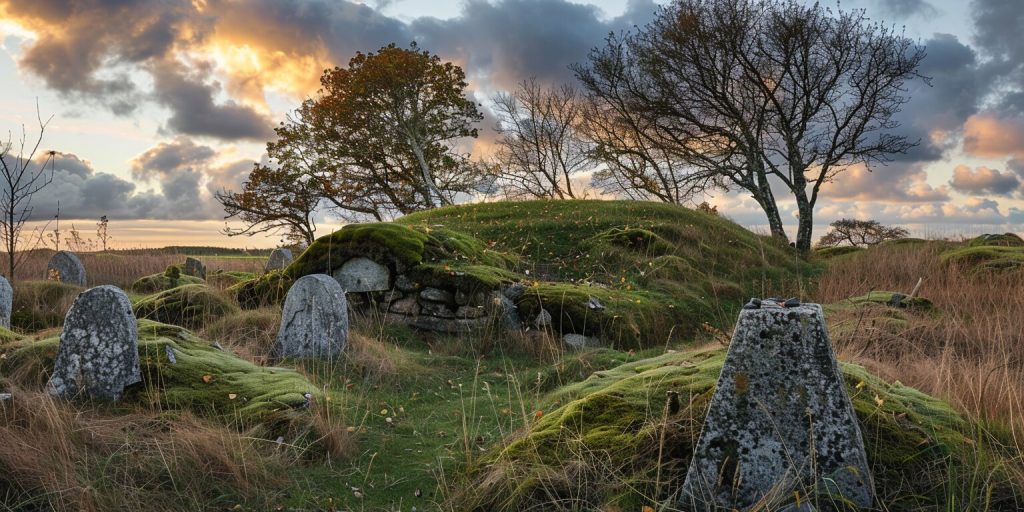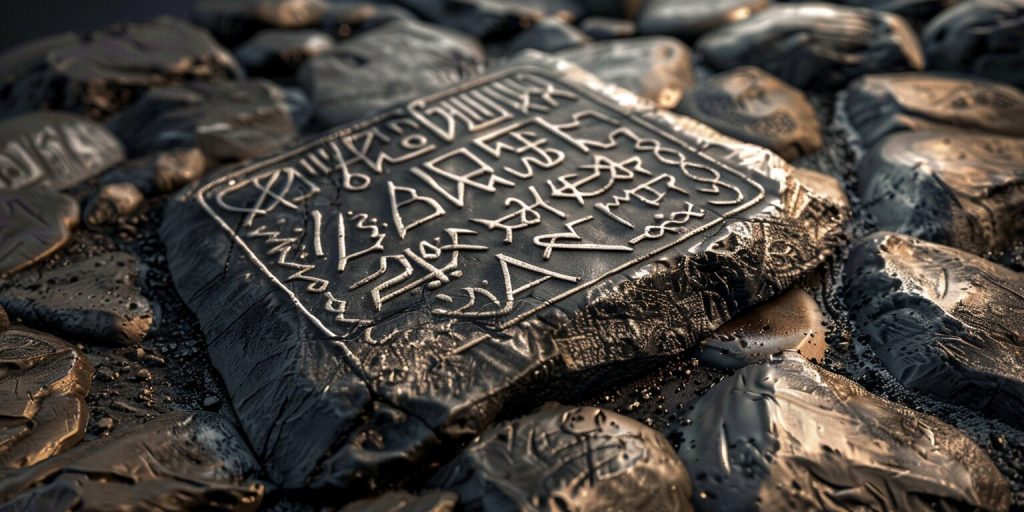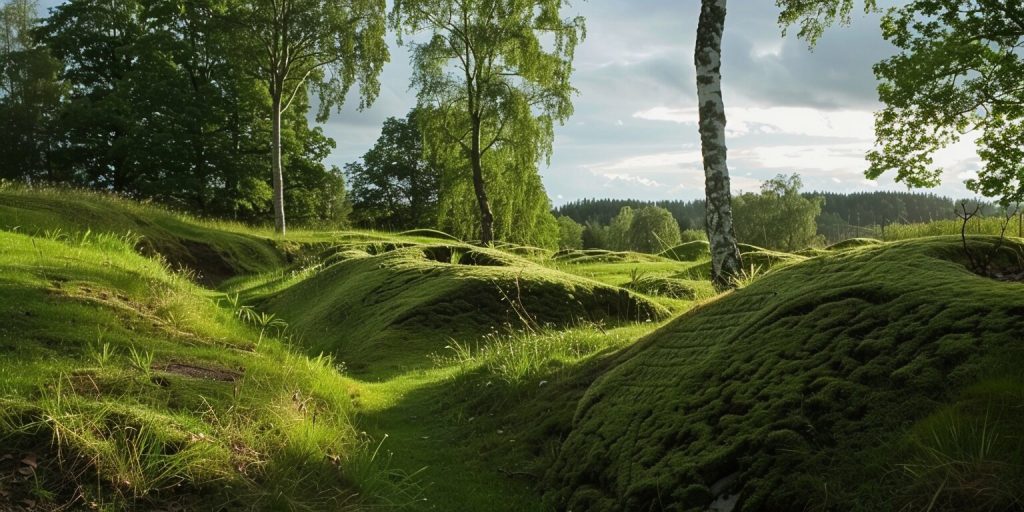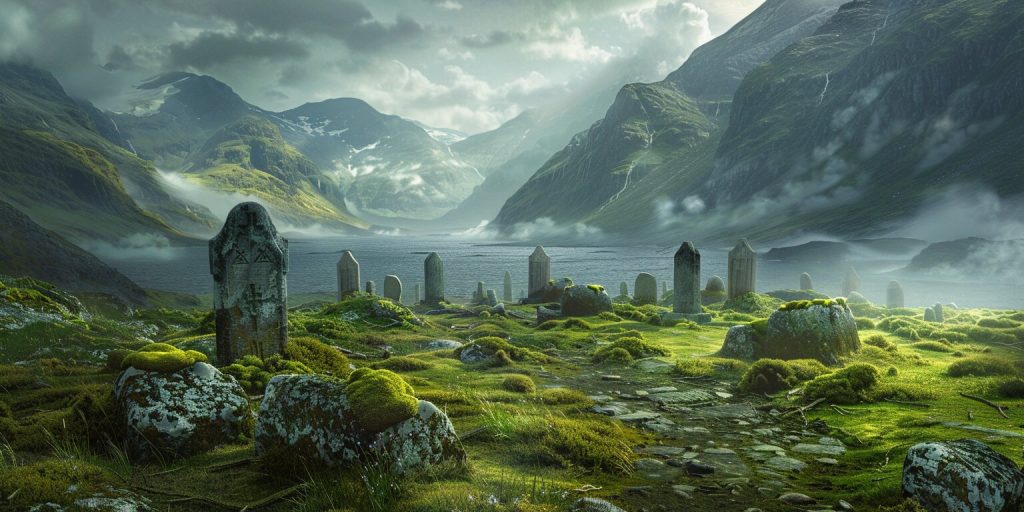Viking Ships, Viking Sites, Vikings
What Are The Most Famous Viking Burial Sites?
Scandinavia’s landscape is filled with the marks of the Vikings. Viking burial sites stretch from Norway to the British Isles. These sites show us the Vikings’ culture and social ways during the Viking Age (8th to the 11th century AD).
The Oseberg Ship Burial and the Jelling Mounds are famous Viking burial sites. They reveal the rich history of these sites and the detailed burial rituals. These rituals tell us a lot about Viking life and death.
Looking at these Viking grave sites reveals more about the Norse people and their lasting impact on history from the Viking period.
The Oseberg Ship Burial
The Oseberg Ship was found in Norway in 1904. It shows the skill of Viking shipbuilders and their burial ways. The ship is very well-preserved, giving us a peek into Viking life and death customs.
Discovery of the Oseberg Ship
The Oseberg Ship, from the 9th century, was found in a big mound at the Oseberg farm near Tønsberg. It was buried under clay and was amazingly well-preserved. The site had two female skeletons, showing the high status of the people, maybe even kings or queens, often adorned with jewelry.
Significance of the Burial Goods
The burial had many valuable items, showing the wealth of the people buried. There was a beautiful cart, fancy sledges, and wooden tools with detailed carvings. These things give us a look into Viking life and what they believed happened after death. The Oseberg Ship is now seen as one of the most important Viking finds ever.
Lindholm Høje: A Viking Age Burial Ground
Lindholm Høje is a key Viking burial site near Aalborg, Denmark. It sits on a hill overlooking the Limfjord, giving a stunning view. This spot was crucial in the Viking and Nordic Iron Ages.
This site is famous for its stone ships and burial mounds. It has over 700 graves, each with stone settings that look like ships. These ships symbolize the Vikings’ journey to the afterlife and their deep connection to the sea.

Excavations have found both cremation and inhumation graves here. They show us how people were buried from the 6th to the 11th centuries. The graves have weapons, tools, and personal items, giving us a glimpse into Viking life and death.
Lindholm Høje was more than just a burial site; it was one of the best-preserved Viking locations. Its high spot above the Limfjord made it perfect for watching the fjord. This was an important route for Viking ships and trade. Its closeness to Aalborg links it to wider Viking trade and communication networks.
- Over 700 graves showcasing stone ships and traditional burial mounds, typical of several burial sites from the Viking times.
- Strategic location overlooking the Limfjord and near Aalborg
- Excavations reveal both cremation and inhumation practices
- Artifacts provide insights into Viking Age life and death, reflecting the incredible Viking culture.
Visiting Lindholm Høje lets us peek into Viking history. It shows us the rich culture and legacy of the Nordic Iron Age.
The Gokstad Ship
The Gokstad Ship was found in a burial mound in Norway. It’s known for its large size and the high status of its owner. This ship shows the grandeur of Viking burial customs.
A High-Status Viking Burial
This Viking burial shows the high social rank of the person inside. The mound had many items, like weapons and a game board. These finds tell us about the rich life and funerals of Vikings back then during the Viking period.
The artifacts found are well-preserved. They show how important the person was in the Viking Age, reflecting the rich culture of Viking times.
Excavation and Archaeological Finds
In 1880, the Gokstad Ship and many artifacts were uncovered. The ship proves Vikings were skilled in building sea-worthy vessels. These items help us understand Viking craftsmanship and warrior culture.
These finds give us a peek into the lives and beliefs of 9th-century Vikings.
The Jelling Mounds and Rune Stones
The Jelling complex is a key part of Viking culture in Jutland, Denmark. It has large burial mounds and detailed rune stones. These were made by King Gorm and his son, King Harald Bluetooth. They go back to the Viking Age and are known for their amazing runic inscriptions.

King Gorm, also called “Gorm the Old,” built the smaller mound. King Harald made a bigger mound and two rune stones to honor his parents and his big wins, like uniting Denmark and making the Danes Christian.
UNESCO has designated the Jelling rune stones a World Heritage site. Their inscriptions tell important stories of Danish history. One stone is called Denmark’s “baptismal certificate.” It shows how King Harald converted Denmark from paganism to Christianity.
The Jelling complex shows the big change from Viking paganism to Christianity. It shows the power of King Gorm and King Harald. Their stories live on through the burial mounds and rune stones. Jelling is a key part of Viking culture and history.
- Location: Jutland, Denmark
- Main Figures: King Gorm and King Harald Bluetooth
- Time Period: Viking Age
- Significance: Transition from paganism to Christianity
The Ladby Ship Burial
The Ladby ship burial is a key example of Viking burial customs in Denmark. It dates back to the early 10th century and is the only ship burial found in Denmark. This site, with its well-preserved ship and many artifacts, shows the Viking Age’s essence.
The Only Ship Burial Found in Denmark
The Ladby ship is a unique find found on Funen Island in the Kerteminde fjord. It was a burial place for a Viking nobleman, making it Denmark’s only ship burial among several burial sites. This site sheds light on Viking traditions and the importance of the journey to the afterlife, reflecting on various Viking sites.
Artifacts and Significance
The Ladby site has many artifacts, like a bucket and a dog skeleton, meant for the nobleman’s afterlife. These items reveal the 10th century’s burial customs. The ship’s outline and burial remains make the Ladby ship a symbol of its historical and cultural value, emphasizing the importance of Viking sites.
The Borre Mound Cemetery
The Borre Mound Cemetery in Vestfold, Norway, is one of the key Viking grave sites from the Viking era. It has the biggest group of burial mounds from the Viking Age in Scandinavia, which shows the grandeur and complexity of Viking burial customs.
From the 7th to the 10th centuries, the mounds at Borre are a big deal for historians and archaeologists. Each mound has its own story through artifacts and how it was made.

Researchers have found many Viking artifacts like buckles, weapons, and tools. These items give us a peek into the daily lives and society of Vikings back then.
One of the cool things found at Borre is the ship settings. These are not just graves but show the Vikings’ love for the sea and tell us about the social hierarchy of ancient Norse societies.
The National Museum of Denmark has saved many of these incredible Viking artifacts. They let us study and show them to the public. This keeps the Borre Mound Cemetery’s legacy alive, helping us learn about a key time in Scandinavian history.
Viking Burial Sites in the UK
Viking burial sites in the UK give us a peek into the Viking age. They show a mix of Scandinavian and local traditions and tell us a lot about the Viking settlers, warriors, and communities that lived there.
Excavation Sites in York
York is famous for its Viking history. Archaeologists have found many Viking artifacts there. A big mass grave in the city shows that many Viking warriors lived there.
These sites have uncovered personal items and weapons, showing how Viking and local traditions mixed at that time.
Finds at Repton
Repton in Derbyshire is also important for Viking history. It was a key spot for the Viking Great Army’s winter camp in 873-874 AD. The discoveries there include many grave goods, including brooches and other Viking jewelry.
These artifacts help us understand the Vikings’ impact and how they interacted with locals. They give us a closer look at how the Vikings buried their dead and adapted to their new homes.
Conclusion
The study of Viking burial sites has greatly expanded our knowledge of this mysterious warrior society. Sites like Oseberg and Gokstad Ship Burials, Lindholm Høje, the Jelling Mounds, Viking burial sites in the UK, the Ladby Ship, and the Borre Mound Cemetery show us the Vikings’ culture and norms. They highlight the Vikings’ complex burial practices and their deep respect for the dead.
Archaeological research at these sites keeps fascinating scholars and fans. It connects today’s Scandinavia with its ancient past, showing the Vikings’ lasting impact. Sites like York and Repton reveal the detailed work of archaeologists to understand the Viking era’s wide reach and its incredible Viking influence.
As we learn more about Viking burial customs and the artifacts found, we gain deeper insights into Viking society. This research promises to bring more exciting discoveries. It ensures that the Vikings’ legacy and detailed burial customs will continue teaching and inspiring future generations.

